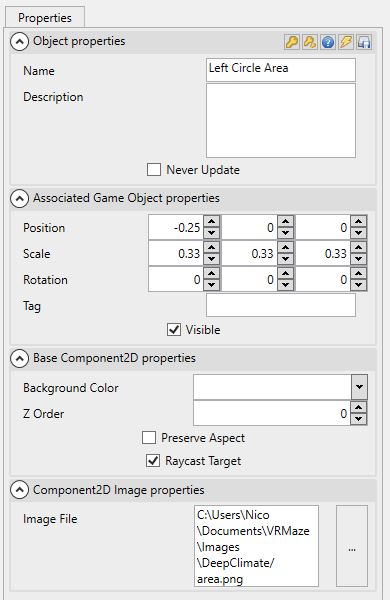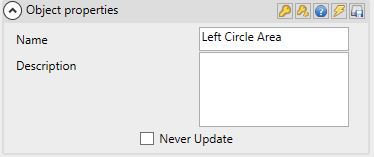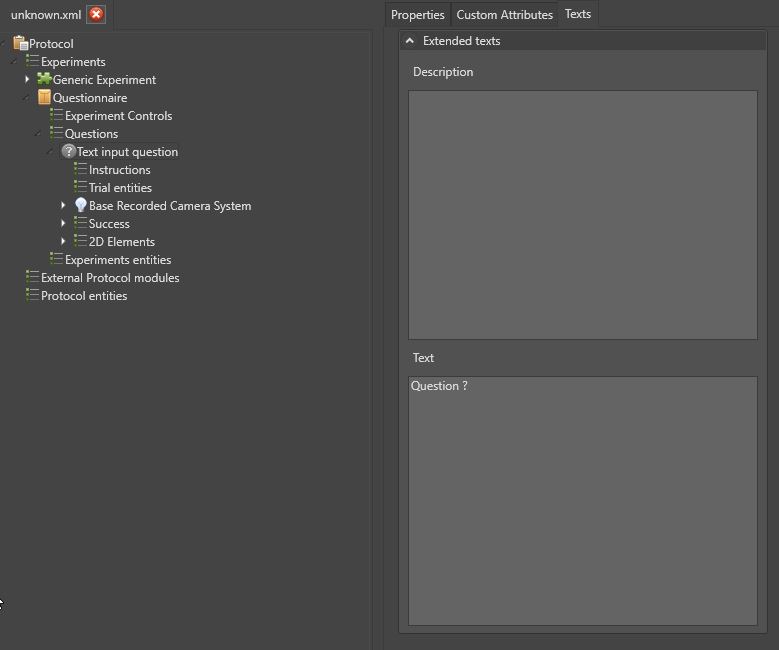Property panel
Case of result files
In case of opening a result file, most of the parameters will be inaccessible which will forbid their modification. This ensures the integrity of the file.
The properties panel

Saving properties
Except in specific cases, all property values are saved in the protocol .Xml file.
Tooltip
Tooltips are available on each property in the panel. Hover over the property name to display it.
Reset Property
Each property has a short pop-up menu to reset the value to the default.
Add a property ?
It is not possible to add a property to an entity.
Generic parameters

All entities, whether node or list has at least the generic properties of name, description and identifier. While the first two are modifiable, the last one is assigned by MindDev automatically when the object is created and can only be modified by a special action.
The name and description are two properties that are not used in the logic of MindDev, so they can take the desired value without impact.
Link between objects
MindDev uses the object identifier to reference an object from another object.
Link between objects in programming
Every object has another property that can only be accessed programmatically, which allows for a more robust link between objects.
In addition, all entities have a boolean property that allows them (and their children) not to be updated when passing. The interest of this feature is to optimize the update loop by avoiding to treat totally static objects.
Optimization of the update loop
In case of a very heavy protocol tree, the processing loop can be resource consuming. If a part of the tree hierarchy is static, for example a 3D environment, it is advisable to avoid updating by checking the "Do not update" box.
Object actions
The generic properties panel has a few buttons for quick actions on the selected object.
Reset ID and reset hierarchy IDs
The identifier cannot be changed directly, MindDev can assign new identifier values to an entity or an entire hierarchy.
Use of action
If no logical link between entities is used in the protocol, this option is not useful.
Identifier formalism
MindDev uses the GUID formalism to assign an identifier.
Entity duplication
When duplicating an entity, or copying, the identifiers are not changed, which can lead to duplicate identifiers. This can cause problems when there is a logical link between entities, as MindDev has several possible choices for the linked entity.
Modification of identifier after link
If an identifier used for the logical link between entities is changed, the link is lost, without MindDev telling you.
Get help on entity type
Built-in documentation provides help on each entity in a protocol tree.
Reset Entity
The reset entity action resets the entity's property values to the default values.
Delete hierarchy ?
Resetting an entity only affects the property values. No deletion of the hierarchy or even modification of the hierarchy properties is performed.
Convert to prefab
It is possible to convert a hierarchical structure into a prefab. This allows complex structures to be reused in one click on other protocols. Adding a prefab creates a structure independent of the prefab, which can be modified without problems and without affecting other instances of the prefab.
Persistence of prefabs
Prefabs are persistent and stored on the hard disk. When MindDev is relaunched, the prefabs will always be available
Name and information
The prefab will take the name of the entity while the tooltip available on the prefab will be completed with the description of the entity used to create it.
Deleting prefabs
There are no tools to delete prefabs in the GUI. These are stored in the prefabs folder of the data folder. Deleting a prefab involves deleting the corresponding file.
Modification of prefabs
It is not possible to modify a prefab after its creation.
Property types
There are several property types in MindDev that allow you to control the value assigned to a property without the possibility of error. :
| Property type | Representation |
|---|---|
| Textual value |  |
| Boolean value |  |
| Numerical value |  |
| List of choices |  |
| Color |  |
| Tuple with 2 components |  |
| Tuple with 3 components |  |
| External reference (image, 3D objects, sounds...) |  |
Value range
Property values can be restricted to a value interval.
No increment
Holding the mouse click on the increment or decrement buttons gives a good indication of the potential value interval of a property.
Reset
Values can be reset one by one using the context menu (right mouse button) on the property name.
Case of the logical reference
There is one more type of property in MindDev: the logical reference. This reference allows to create a logical link between two entities in the protocol tree. The graphical interface shown is equivalent to the external reference, but the selection button will display a small internal selection window.
Entity with logical link ?
Only a few very specific entities use logical links: some scripts and some plugin entities such as the Cave plugin.
The text editing panel
The text editing panel provides a larger text editing area for the selected entity. Indeed, in some cases, the text area associated with a property may be too small for comfortable editing, because the text entered or to be entered is too long. For simplified editing, MindDev has a tab panel offering a different graphical look for text editing, preferring much larger editing areas.

Modified properties
The modified properties are the same as those present in the properties panel.
Using the text editing panel
The text editing panel is especially useful when editing instruction texts and questions. Also, it can be useful for commenting the selected entity via its description property.